2015-06-09 By Robbin Laird
On May 26, 2015, when journalists visited the USS Wasp to engage with the ship’s crew and personnel involved in operational testing, a panel was held at the end of the visit with several Marine Corps and Navy participants in OT-1.
The material presented provided a good overview on the tests and the progress to date.
Because only a small number of people were able to interact with the panel, but very good quality information was provided, in this article, I want to highlight some of the material provided during the panel discussion.
In a companion piece, I will combine the discussions with the XO of the ship, the CO of VMX-22 and one of the maintainers aboard the ship.
The participants in the panel were as follows:
Captain Andrew Smith, USN, USS Wasp Executive Officer, ESG 2;
Major Richard Rusnok, USMC, VMX-22 F-35B Det Officer-in-Charge, F-35 Detachment, Edwards AFB and the lead planner for OT-1;
Major Aric Liberman, USMC, VMFA-121 Special Projects Officer, Yuma, Arizona;
Major Brendan Walsh, USMC, FMFA-121 Operations Officer, Yuma, Arizona;
Major Paul Hoist, USMC, VMFA-501, Director of Safety and Standardization, Beaufort, SC;
SSgt William Sullivan, USMC, VMX-22 Airframes Division Chief, F-35 Detachment Edwards AFB;
Lt. Cdr. Neil Mathieson, Royal Navy, UK F-35B Ship Air Integration Lead, UK MOD< Abbeywood, Bristol, UK who identified his role and task as follows:
“I am here with a team of officers working with the US Marine Corps and US Navy to observe OT and then take any lessons learned to our Queen Elizabeth class carrier:”
Lt. Cdr. Beth Kitchen, Royal Navy, OT-1Evoultions Lead, VFMA-501, Beaufort, SC who identified herself as follows:
“I’m the Senior UK Engineering Officer at 501 Squadron at Marine Corps Air Base Beaufort. With the purposes of this detachment, I have been intrinsic to the maintenance organization, coordinating all maintenance resolutions where we’ve identified that there might be differences between how they’re executed on sea and on land.”
Also joining was Major Mike “Gravy” Roundtree, who discussed maintenance issues as the maintainers were working on the planes for the afternoon sorties and exercises. The last time we saw Roundtree was when he flew the 199th sortie of the F-35B on August 24, 2012 at Eglin AFB, then the home of the Warlords. He is still with the Warlords but they have been relocated to their permanent home at Beaufort, SC.
https://sldinfo.com/we-are-on-the-front-side-of-something-big/
He described his role as follows: “I’m the Aircraft Maintenance officer at the Marine Attack Training Squadron 501 at Beaufort. I’m serving as an operational training officer to call, train all the pilots to landing on the ship.”
Captain Smith, the XO of the ship, provided an overview on activities aboard the USS WASP.
The primary purpose of this event was to take what we’ve done with the F-35 in developmental testing and handing the effort now to the operators.
DT1 and DT2 were very data driven exercises, where we went out and tried to exercise the aircraft in order to get test points.
What we’re trying to do now is to develop the tactics, techniques, and procedures of operating this aircraft at sea effectively and efficiently.
From the perspective of planning this event, we have taken five different squadrons and multiple other organizations, technical experts across the joint program office, industry operational test team, we brought them out as well.
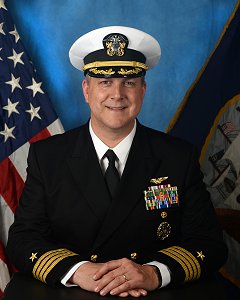
And the idea was to take six aircraft, which is the same size as the Marine expeditionary unit, which would be a normally deployed six-plane detachment which is part of that rotation, and take them out here and exercise them aboard the ship.
We can then learn how to make this aircraft function as a normal deployed aircraft outside of the normal test, developmental test environment.
Our primary focus here has been upon supportability.
That was one of our major emphases.
If you look at what General Davis and his team put together as priorities for what they wanted us to look at while we’re out here, the vast majority of those were focused on supportability.
LT CDR Kitchen together along with the other maintenance officers, put together an extensive list of items that we wanted to make sure that were functional at sea.
That goes from the mundane like changing a tire to the complex, like changing an engine.
Doing those evolutions at sea is a different animal.
You’ve got chains, you’ve got deck motion, you’ve got all those space constraints that you saw down in the hangar deck that you don’t have ashore.
We want to make sure that any differences that we saw from support ashore to afloat were properly documented and we make those changes with the ultimate goal of making the deployment for the very first squadron that’s going to go to sea as easy as possible.
From the effectiveness side of the equation, it was getting ten pilots out here and used to operating around the ship, and getting the ship used to operating 35’s on board, getting the deck crew used to moving an aircraft that is much larger than what they’re used to operating with on this somewhat smaller deck than what we would see on a normal big-deck aircraft carrier.
Functioning as a team, and that’s really what we’ve done over the first week.
And I think based on what we saw this morning, you could see how efficient the operations have become just over that one-week time span.
Question: How have you done with regard to supportability of the aircraft on board the ship?
Lt. Cdr. Kitchen: I’ll start by touching on the main solutions that we’ve conducted.
A large proportion of those main solutions that we’ve conducted have not directly been required as a part of the service of the aircraft themselves.
We have gone over and above basic maintenance requirements.
Among those things we have done over an above any basic maintenance requirements include: conducting demonstrations for installation removal of the engine, the lift back, and the integrated compartment, the canopy, and the ejection seat…..
At sea, we obviously have a moving deck.
We have looked at how we tie down the aircraft from very calm sea states up to heaviest possible sea states.
And these have taken a huge amount of time.
The good news is that we have gone through all of these evolutions, we have identified lessons, and majority evolutions we are confident that we can now conduct at sea.
The real difference between DT2 and DT1 and OT is the fact that this first time that Marines have been responsible for conducting maintenance.
So part of that verification was not just ensuring that we ensured that the equipment, the tools, the procedures in the ship environment worked but also that we trained the maintainers correctly.
And that’s why this detachment has been hugely a success not just from a flying perspective but a maintenance one as well.
Question: With regard to the UK personnel, it is clear that you view the USS Wasp operational trials as an important input to the preparation for operations aboard your own new carrier, HMS Queen Elizabeth.
Could you comment on how you are leveraging the working relationship with the USN and USMC to get ready for your own carrier, one which is specifically built for the F-35B?
Lt. Cdr. Kitchen: UK personnel have been working with the Marine Corps now for about two and a half years.
I personally have been here in the States for a year working with the Marine Corps at Marine Corps Air Base Beaufort.
Our programs are aligned and they’re working in partnership in order to develop the capability of the 35B.
In terms of this ship deployment, we’ve got other UK maintainers who have been a part of the detachment.
We’ve got personnel who are working within the power line with the avionics department as well as any maintenance control.
And they are able to contribute to the maintenance effort in exactly the same way as the Marines are.
They are trained in the same way in the schoolhouse down at Eglin.
But the Marines also they are learning to look at how the UK conducts maintenance and how that can possibly be involved in the future.
Lt. Cdr. Neil Mathieson: As I mentioned during introductions, myself and the team from the UK are here observing OT and taking a lessons from the Marine Corps and the US Navy back to the Queen Elizabeth.
And the great news is we have seen a lot this week and validated a lot of our assumptions.
As you said, Queen Elizabeth has been specifically designed around about the thirty of the F-35Bs.
So a lot of the infrastructure, the support issues, how the deck is operated, a lot of what we have seen this week has validated all of our assumptions, all design assumptions we have for the ship and puts us in a very good place.
And obviously the partnership with the Marine Corps is crucial to all of that and it has been a fantastic opportunity for us to come over and see what the USN and USMC have been doing.
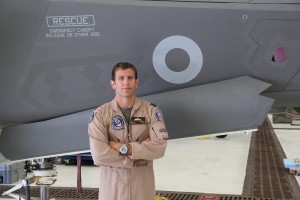
Question: When you start getting B-35Bs in Britain?
Lt. Cdr. Neil Mathieson: We already are getting them.
Our first squadron is being set up alongside VMFA-501 at Beaufort.
In 2018, that squadron will “lift and shift” from Beaufort and stand up as 617 Squadron in the UK.
Our presence at Beaufort will grow to approximately 250 at Beaufort.
http://www.raf.mod.uk/news/archive/dambusters-to-be-next-lightning-ii-squadron-18072013
Question: What has the British team learned from these trials that requires more work?
What about the deck, for example?
Lt. Cdr. Neil Mathieson: The US and Royal Navies are certainly aware of the impact of the impact of F-35B jet launch on the deck.
You will have seen on the flight deck something with a slightly different color coating.
That is a product that working with the Naval Research Lab as a research program with regard to high temperature deck coatings.
The UK is working hand in glove with N95 to understand that deck coating improvements and take it across with application on Queen Elizabeth.
Commercial issues are involved as well as there is a company in the UK that does this work as well as a company in the US that does the work.
And it’s really a research program just right now where we are measuring temperatures in the deck structure and learning if that product is going to be good enough to coat with.
So that’s one area we are learning every single day.
And actually one of many that we’ve seen throughout the week where we see an issue, we’re working the issue and we’re confident that there will be a solution by the end of the day.
Lt. Cdr. Kitchen: I can cover maintenance supervision lessons.
I think from my perspective this has been a very positive detachment.
Because what we’ve actually demonstrated is almost all of the maintenance evolutions that have been attempted we are now confident we can now conduct at sea.
There have been lessons identified where some of the equipment doesn’t necessarily interact with the ship’s facilities.
But these are all things that can be easily rectified.
For example, we wouldn’t be able to conduct a lift fan movement installation today only because we need an additional shackle that interfaces between the ship’s overhead crane and our lifting equipment.
This is a very simple piece of equipment to source and with this detachment it can be resolved.
It’s the same with a number of issues like that.
So, from a program perspective this has been successful.
A lot of observations will be sent back to the joint planning office and there are people who will be taking those lessons.
I’m not going to be requesting many procedural changes to joint technical documentation.
The tools that maintainers use though, I’ll allow SSG Sullivan to elaborate in a second, all seem to be fit for its purpose.
Even things like the automated logistic information system have gone exceptionally well here.
We haven’t struggled with connectivity.
None of the maintainers have reported that it has been any slower than it is on shore.
Which is a huge positive step for us.
Every detachment will have lessons to learn so we can evolve and make everything better and quicker.
And those are things that we are going to be taking back.
But the headline news is we are confident that we can maintain these aircraft at sea for periods of time.
SSgt William Sullivan: As far as tooling and things that we’ve used while on the ship, we’ve been all around successful.
I can’t think of any issues we’ve had aside from possibly a few things not going where they should with the extra shackle.
The aircraft jacking, which his obviously kind of a precarious activity, went extremely well.
I was very impressed with that.
As far as at sea versus on shore maintenance, we haven’t seen a whole lot of things go wrong.
Things have been going very smoothly from my point of view.
And obviously there are things as far as being on the ship that will take more time.
Obviously transcending decks and chaining aircraft and things of that nature are different at sea than ashore.
But as far as I’m concerned it’s gone very well.

Question: What about stealth maintenance?
SSgt William Sullivan: The cell coatings on the aircraft F35 obviously are very advanced and have held up extremely well.
The recording of signature health of the stealth coatings has all gone successfully as well.
Lt. Cdr. Kitchen then went back to the earlier question about lessons learned to date with regard to maintenance.
The actual engine installation removal demonstration, which was conducted last night, that was relatively straightforward.
Our biggest concern was whether there would be sufficient space within the hangar to maneuver one engine out and obviously relocate another one in.
But the actual evolution itself is not any different from conducting it on shore so we are confident that that can occur.
One of the bigger successes of this detachment is actually embarking a power module onto the ship, which is about two thirds of the engine.
It was carried on the MV-22, and that arrived last Wednesday, there was a custom made skid that was designed by Pratt and Whitney and put it into the MV-22, it was then offloaded, and then we’ve been able to put it into the hangar and been able to prove that we can move it from the skid it was designed to put into the aircraft onto either a container or one of the maintenance vans in order to actually conduct the maintenance evolution itself.
That is going to be disembarking tomorrow.
That ensures that we can now replenish a spare module at sea.
It’s a huge achievement to be able to demonstrate that.
Question: What about flying the aircraft on and off the ship?
How did that go?
Captain Andrew Smith: The aircraft itself flies fantastically.
It’s an incredibly smooth flying airplane that is much easier to fly from a pilot perspective than the Harrier was, especially around the ship and the ship environment.
The training we did for this detachment was much less than the training we did in a Harrier fleet to get to a ship.
And that’s just a testament to the ease of the airplane to fly, the pilot vehicle interface, as well as the simulators that we have on shore that allow us to recreate to a high degree of detail the ship environment.
We took pilots from across the spectrum. From East Coast, West Coast, Harrier, Hornet, two-seat, single seat, ship experience, no ship experience since flight school and we put them on this deck very easily in a very short amount of time with a short amount of adapting to the ship environment.
And you saw the results today.
It is a testament to the ease of the airplane, to its design specifications to how they execute those design specifications, and how easy it is for us to just adapt to flying the airplane.
The ship boarding rate is as high if not higher than the Harrier right now.
I don’t enough data points to give you an exact number, but I can tell you from experience over a large number of landings in the Harrier and observing in the tower that this airplane is going to have a fantastically high boarding rate.

Question: What is a boarding rate?
Captain Andrew Smith: That’s the ability of the airplane to get aboard the ship without having to divert ashore.
It’s something we’re very concerned with because we’re always trying to maintain the ability to divert in case of a problem.
Well, we haven’t had any problems.
Question: What is the difference between flying the Harrier and the F-35B with regard to operating on this ship?
Captain Andrew Smith: The takeoff and landing portion of the F35 is seamless with the ship.
It is much easier to execute from the pilot perspective as well as the single officer perspective up in the tower.
We were able to, in a very short period of time, smooth out all of our process with the ship, have a team of three organizations come together, fly together for the first time, set up standard operating procedures (SOP) and function around the ship in a seamless manner.
And most of that is due to the fact that the jet takes care of a lot of the task loading that was resident in the Harrier and is not resident in this airplane.
So now we are able to pay attention to flying around the ship, and being a good steward of the aircraft and the ship at the same time, and bringing aboard exactly on time, exactly on the fuel safe that I’m looking to be aboard by.
Question: What blocks of software on the six airplanes?
Captain Andrew Smith: There are four block 2B aircraft and two block 3I aircraft.
Major Richard Rusnok: Each iteration of software that comes up has associated increase in envelope capability.
So from the 2B perspective, the airplane is capable of about 550 knots or 1.2 mach, about five and a half Gs. 5.5 Gs. So that is what the envelope we’re currently flying to and that’s the out of sea envelope.
As the airplane becomes a 3F aircraft, it will get out to the 7G envelope, 630 knots and 1.6 mach. So that’s to come. That will be in the 2017-2018 time frame. That’s after all the flight-testing.
Question: What is the biggest surprise for you about this aircraft aboard the ship?
Captain Andrew Smith; I think for many it’s the situational awareness it gives you.
The other day I took off and all the combat systems that are supposed to be working in the configuration were working and in the shipboard environment which is a very challenging environment.
And I was just very impressive to me to launch off of the ship, have everything working that should be working, and then complete a tactical mission with a couple other 35’s.
And it’s awesome to see that in the shipboard environment.
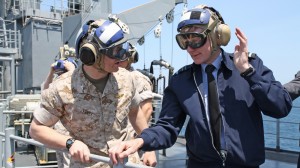
Question: You mentioned that the maintenance is done organically by Marines; what does that mean exactly?
Major Richard Rusnok: The maintenance aboard the ship is a 100% Marine-lead effort.
We have 91 maintainers on board, 91.
And that is built off the same number of maintainers we would take with a Harrier detachment.
So the numbers are comparable to legacy numbers that we would bring aboard.
We spent a lot of time studying and analyzing bringing which specialties out and we’ve learned some lessons like anyone would learn.
Like we wish we could have another Marine here, another Marine there. But as far as numbers, we’re completely comparable with legacy.
And the great part about it is the 91 Marines we’re not just turning airplanes and flying a robust flight schedule.
We’re also doing all of these evolutions and all these other demonstrations, validation and verification of brand new procedures that have never been done before.
So, they’re busy. They’re working hard. But they are working hard and having incredible results.
As far as keeping up with the daily flight schedule as well as validation and verification of these tasks.
That’s probably about it.
There’s three squadrons of maintainers on board from VMX 22, and 121 and 501.
So we’ve got three different patches in the maintenance department.
And if you can imagine a team coming together for the first time, can be challenging.
We have not had any of those kinds of challenges here because of the standardization and the level of training and the level of verification that has already been done on brand new procedures.
The Marines have done incredibly.
That’s the best news story of this detachment, is how well the maintenance work has gone thus far.
We have extremely high reliability ratings for being in the shipboard environment.
Question: How would compare landing on this ship versus a large deck traditional Navy carrier?
Major Brendan Walsh: The first major thing that I noticed was that the deck is straight line all the way in.
In many ways that takes a lot of the variables out of the landing pattern that you even have to do in daytime.
And you use an optical landing system very similar to what we have on the big deck carriers.
But then you also get to stop over the ship.
And you don’t have that last two seconds of very intense ball flying as we call it, CPM, where a lot of things can go wrong if you’re not very careful with your power settings or hitting the verbal on the backside of the carrier.
So the fact that you kind of get to stop and square yourself way and then you have another landing aid.
The hover position indicator which allows you to stop, get yourself in position before the landing signals officer clears you to land, its less emotional.
Question: What is up next on the path to IOC after these operational trials?
Major Brendan Walsh: I think that on all the training that we’ve done we’ve been validating how we are preparing to get initial operational capability in this airplane.The test environment has dropped a lot of ordinance, and that’s something that us as the IOC squadron need to do in the coming month.
So that is the next thing looming large for me as soon as I get back off the ship.
We’ve got a lot of weapons for each pilot to drop.
We have several missiles that we’re going to shoot in the June and July time frame and so in my mind, that last end to end check of how the ordinance performs off the aircraft based on the data and tests, it’s really the last thing that I’m looking for personally.
I know we have the right pilots assembled, I think we’ve validated our maintenance procedures, on land and at sea, and I can speak to the training that we’re working very hard to make sure our pilots are ready based on tactics, techniques, and procedures we have.
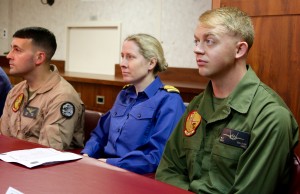
Question: What advantage does the F-35 bring an amphibious ship like the WASP?
Major Brendan Walsh: No one in the world has ever sent an airplane off of an amphibious ship with this level of situational awareness and fusion between aircraft to aircraft and aircraft to ship.
The fusion of the data aboard the airplanes and your ability to see what other planes are seeing a number of miles away from you as well as what the ship is seeing and then to be able to communicate with them without using the radio is a tactical and strategic advantage that can not really be over stated.
I’m not sure we can go into very specific instances, but the amount of situational awareness that I had with 360 degree view around my aircraft the other day, with all the things going on out here in this particular area of the sea space was extremely impressive.
And getting 4 F35’s together to, once again, tie back into all the other information sharing, perhaps one of those fighters just has to find that target, and finds that everyone else now knows where that target is.
So if you think about that in a multi threat scenario, you can have several fighters taking care of preps and air-to-air picture while other guys are finding perhaps targets that you are trying to strike.
And when one of them is tasked, you know what everyone is doing and you see the common picture in the battlefield because it’s being shared amongst the guys that are doing one specific thing.
Question: How is the ALIS system working onboard the ship?
Major Brendan Walsh: The way developmental tests use ALIS is completely different from the way that the operational squadron use ALIS. So, because those aircraft are very unique compared to the fleet aircraft, they don’t use the standard systems that are here. It’s kind of an apples and oranges comparison in that respect.
We spend a lot of time trying to risk reduce coming out here for the ship and transfer. That was a major portion of our planning to make sure that went very smoothly, and as we’ve already stated it did go incredibly smoothly.
LT CDR Kitchen talked about the usage of ALIS already aboard the ship. As far as the deployable capability we currently have SOUV 1, that’s Squadron Operating Unit Version 1 onboard and that is permanently installed in racks. We have a special space, and this was provided through NAVSEA, special space for the appropriate security and classification to have it on board. It’s essentially bolted into the space right now.
And then when the SOU Version 2 comes out which is already being delivered to 121 in Yuma, then that will allow us to do one of the unique things with amphibious shipping is our ability to disembark from amphibious shipping once we get in the theater.
Then it’s something that is very unique to this ship into the units that embark with this ship is we don’t necessarily have to stay aboard the ship.
The operational environment, the requirements say go ashore, and base ashore, and base of foreign operating bases.
SOUV 2 will allow us for all intents and purposes, the same hardware is packaged differently and will allow us to take it off and put it in a forward operating base and to operate effectively and efficiently closer to troops away from the sea base we have currently.
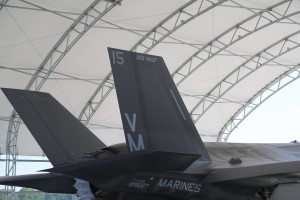
Question: Recently, I visited Beaufort and the level of effort you are already putting into integration with legacy aircraft (F-18s at the base) and with the USAF in the Georgia Air National Guard is kind of a missing factor in evolving your capabilities.
Could you comment on that?
Major Mike Roundtree: That’s a testament of not just the airplane but the people the Marine Corps has chosen to put into this program that the moment we’ve gotten the aircraft or gotten block upgraded hardware or software, the first thing we do is look to see how we can use this airplane tactically and strategically.
We develop the syllabus, we develop the training programs, and we go out and do it. On the East Coast out of Beaufort we’re fortunate enough to have a large base in Savannah where we can integrate large exercises many times a year with F22, F16, F18, F15 and do large force exercises.
We use that opportunity to train our pilos. As well as to push the boundaroes of the airplane in a inter-connectivity type of way.
That’s all part of the development, the tactics, and our desire to develop this airplane fully from the beginning and look towards the future, future capabilities, and also start developing those tactics to try to get ahead of the curve.
And Lt. Cdr. Kitchen put on the finishing touch to the panel with this comment:
The F-35 can be surrounded by myth and legend.
But it is a real testimony to the capabilities of the maintainers of the Royal Navy, the Royal Air Force and the USMC to adapt to the new technological challenges.
Their knowledge of aircraft systems is now being applied to a new air system and taking steps forward into the unknown.
It is a testament to the professionalism of these maintainers that they are just getting on with the job of making this aircraft work.
Every single person involved in this detachment are passionate about this aircraft and not just because it is a sexy looking aircraft but want to see it working in every operational environment.

